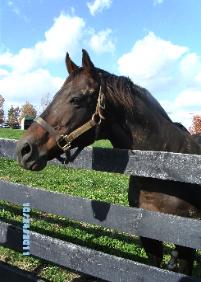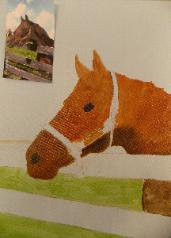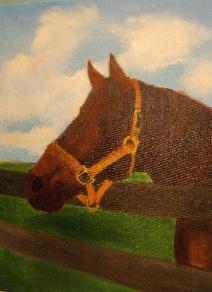Horse Portraits by Brianna's Art and Gallery

How to paint a horse portrait in oils:
| First: Decide on photo and size of canvas. Prepare canvas with acrylic paint or tinted gesso. I decided on light blue acrylic because my background would be a landscape with bright blue skies. Second: Transfer the photo (either enlarged copy or designed painting on drawing paper) to the canvas. Third: Base in your painting with background colors. I used cerulean and cobalt blue for the sky leaving lighter areas for the clouds; raw umber, burnt umber, burnt sienna, and ivory black for the horse's head; and sap green to base in the background grass. Canvas size: 16" by 20" (See the "base in" photos below) |





| Original Horse Photograph by Brianna |




| Brianna painting one of her many horse photos. |
| All photos and paintings copyrighted by Brianna's Art and Gallery |

| Basing in the painting: "Basing in" means that the canvas is quickly covered (usually in first sitting). Then, with each sitting, the colors build up in thickness and value to give the final painting a three-dimensional effect. My favorite oil medium (to move the paint) is Winsor and Newton's Liquin Original. For cleaning brushes, I always use an orderless turpentine. |
| I always keep my photo handy for reference |
| The painting on the right is completely based in. Let the colors dry (about three days) before beginning the detail. When basing in a painting, keep in mind the shadows and lights, but with only a hint of the finished detail. At this point, my colors are thin and almost transparent. Note: If preferred, the clouds can be painted in while the sky is still wet. |
| Finished Portrait (for comparison) |


| This photo was taken at: Old Friends- A Facility for Retired Thoroughbreds This farm is for retired race horses. |
| One of my next projects will be created from a photo taken at Darkey Farms-America |








| When adding the clouds, I used yellow ochre in the white, then added shadows mixed from cerulean blue, alizarin crimson, yellow ochre, and ivory black. If you look closely at real clouds in the sky, you will observe the shadows in soft violet gray. |
| A magnifying glass is helpful for observing fine details. |
| With each painting session, the portrait becomes more alive. I want my paintings to almost breathe. The painting should have more life than the photograph. |
| The fence and grass start with dark, then the sunlit highlights are added and blended. The portrait's shadows are not as dark as in the photograph because photographs tend to have darker shadows than real life. |
| Almost done! However, the portrait must be studied carefully from close up and far away. Any changes can be made. The completed portrait is painted with a fine coat of Liquin for a finished look. Changes can still be made, but must be coated with Liquin so the changes will blend in. |

